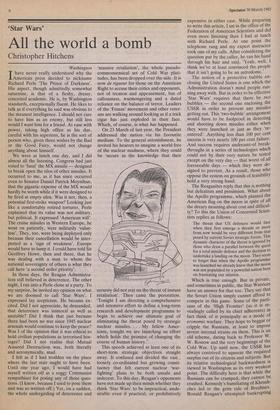'Star Wars'
All the world a bomb
Christopher Hitchens
We were at lunch one day, and I did almost all the listening. Congress had just voted to 'fund' the MX missile — designed to break open the silos of other missiles. It occurred to me, as it has since occurred even to Senator Daniel Patrick Moynihan, that the gigantic expense of the MX would hardly be worth while if it were designed to be fired at empty silos. Was it not, then, a potential first-strike weapon? Looking just like a comfortably retired torturer, Perle explained that its value was not military, but political. It expressed 'American will'. The cruise missiles in Western Europe, he went on patiently, were militarily 'value- less'. They, too, were being deployed only because their cancellation would be inter- preted as a 'sign of weakness'. Europe would have to lump it. I could have told Sir Geoffrey Howe, then and there, that he was dealing with a man to whom the national sovereignty of others is what they call here 'a second order priority'.
In those days, the Reagan Administra- tion still believed in deterrence. The other night, I ran into a Perle clone at a party. To my surprise, he invited my opinion on what we are doomed to call 'Star Wars'. I expressed lay scepticism. He became ex- cited. Did I not appreciate, he demanded, that deterrence was immoral as well as unstable? Did I think that just because there had been no war since 1945 nuclear arsenals would continue to keep the peace? Was I of the opinion that it was ethical to hold civilian populations as terrorised hos- tages? Did I not realise that Mutual Assured Destruction was, both literally and acronymically, mad.
I felt as if I had trodden on the place where the last stair ought to have been. Until one year ago, I would have had myself written off as a soggy Communist sympathiser for posing any of those ques- tions. (I know, because I used to pose them and was so written off.) Yet, On a sudden, the whole undergirding of deterrence and 'massive retaliation', the whole pseudo- commonsensical set of Cold War plati- tudes, has been dropped over the side. It is now de rigueur for those on the American' Right to accuse their critics and opponents, not of treason and appeasement, but of callousness, warmongering and a dated reliance on the balance of terror. Leaders of the 'Freeze' movement and other veter- ans are walking around looking as if a trick cigar has just exploded in their face. Which, of course, is what has happened.
On 23 March of last year, the President addressed the nation via his favourite medium. To the general astonishment, he invited his hearers to imagine a world free of the nuclear madness, where they could be 'secure in the knowledge that their security did not rest on the threat of instant retaliation'. Then came the peroration. 'Tonight I am directing a comprehensive and intensive effort to define a long-term research and development programme to begin to achieve our ultimate goal of eliminating the threat posed by strategic nuclear missiles. . . . My fellow Amer- icans, tonight we are launching an effort which holds the promise of changing the course of human history.'
This speech achieved at least one of its short-term strategic objectives straight away. It confused and divided the vast., loosely co-ordinated but growing consti- tuency that felt current nuclear 'war- fighting' plans to be both unsafe and indecent. To this day, Reagan's opponents have not made up their minds whether they think 'Star Wars' to be impractical, unde- sirable even if practical, or prohibitively expensive in either case. While preparing to write this article, I sat in the office of the Federation of American Scientists and did even more listening than I had at lunch with Richard Perle. At one point the telephone rang and my expert instructor took one of my calls. After considering the question put by the caller, he ran his hand through his hair and said, 'Yeah, well, I think we've at least convinced the people that it isn't going to be an astrodome.' The notion of a protective bubble en- closing the United States is one which the Administration doesn't mind people run- ning away with. But in order to be effective 'Star Wars' requires that there be two bubbles — the second one enclosing the USSR in order to prevent any missiles getting out. This 'two-bubble' arrangement would have to be foolproof in detecting and shooting down missiles either when they were launched or just as they 're- entered'. Anything less than 100 per cent success is very nearly 100 per cent failure. And success requires undreamt-of break- throughs in a series of technologies which could not by their very nature be tested except on the very day — that worst of all foreseeable days — which they were de- signed to prevent. As a result, those who oppose the system on grounds of feasibility hold a very strong hand. The Reaganites reply that this is nothing but defeatism and pessimism. What about the Apollo programme, which planted the American flag on the moon in spite of all the dreary moaning about cost and difficul- ty? To this the Union of Concerned Scien- tists replies as follows:
The threat that US defences would face when they first emerge a decade or more from now would be very different from that posed by current Soviet strategic forces. This dynamic character of the threat is ignored by those who draw a parallel between the quest for a total missile defence and the decision to undertake a landing on the moon. They seem to forget that when the Apollo programme was launched we already knew that the moon was not populated by a powerful nation bent on frustrating our mission.
Which is true enough. But in private, and sometimes in public, the Star Warriors have an answer for that too. They say that the Soviet Union simply cannot afford to compete in this game. Some of the parti- sans of the 'High Frontier' (as it is re- vealingly called by its chief adherents) in fact think of it principally as a mode of economic warfare. They hope to beggar or cripple the Russians, at least to impose severe internal strains on them. This is an old scheme, dating back to Professor W. W. Rostow and the very beginnings of the Cold War. Up until now, the USSR has always contrived to squeeze the required surplus out of its citizens and subjects. But its relative technological backwardness is viewed in Washington as its very weakest point. The difficulty here is that while the Russians can be cramped, they cannot be crushed. Kennedy's humiliating of Khrush- chev led to the grim rule of Brezhnev. Ronald Reagan's attempted bankrupting of Mr Gorbachev leads we know not Where . This consideration is of course !in:important if you take the view that all Soviet leaders are cut from the same cloth, or if you make the illogical deduction that it therefore makes no difference who corn- mands the Politburo. It is a safe assump- tion that today's American leadership holds a version of the second view.
The economic effects on the United States are somewhat different. The outlays involved are (for once one can use the word properly) astronomical. The cost of the electric power plants for the untested laser system would be no lower than $40 billion and perhaps as high as $110 billion. Merely by shortening the boost phase of their missiles to 50 seconds, the USSR could raise that bill to as high as $300 billion. And these are the costs of earth- bound facilities alone. Nobody has even begun to reckon the price of building the gigantic fail-safe orbiting mirrors which would deflect these lasers with unre- hearsed pinpoint accuracy at flocks of Soviet missiles yet unbuilt.
But it is the money that excites people. Every high-tech aviation conglomerate in the land is rushing to contribute money to Pro-'Star Wars' politicians and founda- tions. The 'research' budget for the prog- ramme is already running at $29 billion — more than the building cost of many sophisticated bombers and submarines. The greatest procurement pork barrel in history is being opened up. Lockheed and
Boeing are purveying their star wares. So I doubt whether the distinction made by Mrs Thatcher in her speech to Congress, be- tween 'research' and 'deployment', can long endure. The 'Star Wars' lobby shows every sign of developing 'momentum', and the whole administration has already staked its moral and political credit on the idea, which second-term Administrations are not prone to do with trial balloons.
So far from stopping the arms race, or even reversing it, as Reagan last year sanctimoniously claimed it would, 'Star Wars' forces that race into what may be its final straight. If we take Mr Weinberger at his word about Soviet duplicity in stretch- ing the anti-Ballistic Missile (ABM) treaty (which we certainly should on the available evidence), then we have to assume also that they mean to compete in the astro- dome race. This would vindicate the judg- ment of William E. Burrows, director of the Science and Environmental Reporting Programme at New York University. Long before the March 1984 Reagan speech, Burrows wrote an article which anticipated every development that has occurred since. I think his concluding paragraph should be on record:
But where is this race likely to end? Amer- ican fighting mirrors, laser battle stations, space planes and manned attack platforms will sooner or later co-inhabit the heavens with their Soviet counterparts. Orbiting las- ers made in California will be closely fol- lowed by space mines made in Yaroslavl, and
although the lasers may be technically super- ior to the mines, that will count for little or nothing if the mines do their job at the crucial moment. It will therefore be deemed imperative to develop weapons that can attack the mines before they attack the lasers that are supposed to attack the ICBMs that are launched to attack the cities and silos. The prospect — now nearly at hand — of extending the vast and intricate network of super-sensitive warning systems and hairtrig- ger explosives hundreds and thousands of miles straight up is stupefying. The earth itself will have been turned into a gigantic orbiting bomb.
That is nearly the most sobering thing that I read in the course of trying to educate myself about this business. I say 'nearly' because there is a more sobering moment in Strobe Talbott's compelling book Deadly Gambits, which is subtitled 'The Reagan Administration and the Stale- mate in Nuclear Arms Control'. Talbott, one of the most earnest member of the American mainstream, describes a meeting between Reagan and an informal group of Congressmen in late 1983, where the lead- er of the Free World told his legislators that land-based missiles have nuclear war- heads while bombers and submarines don't'. As Talbott records:
Even as he said these words, his voice dropped and wavered, as though he had forgotten his lines and knew there was something not quite right about his attempt to improvise.















































 Previous page
Previous page